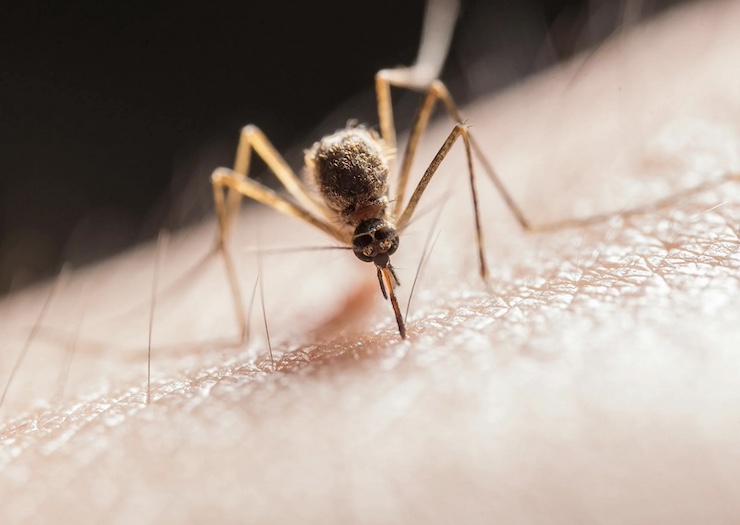
According to research conducted by the American media outlet CNET, nearly 1 million people are killed by mosquito bites yearly, making them the deadliest creatures on Earth. As explained by the CDC, “Only female mosquitoes bite people and animals to get a blood meal. Female mosquitoes need a blood meal to produce eggs. Mosquitoes get infected with germs, such as viruses and parasites, when they bite infected people and animals. A few infected mosquitoes can start an outbreak in a community and put you and your family at risk of becoming sick.” As vectors, species that carry and transmit disease, mosquitoes spread diseases such as dengue virus, yellow fever, West Nile virus, and malaria, to name a few.
Mosquitoes infect more than 700 million people around the world. With more than 3,700 types of mosquitoes, they can be found in nearly every corner of the world, with the exception of Antarctica and a few subpolar islands like Iceland. Generally, mosquitoes thrive in wet environments but can often be found in dry or even freezing climates. As temperatures continue to rise each year, mosquito populations are growing. For most people, interactions with mosquitoes are simply annoying: a few itchy bites, an irritating whining buzz — no big deal. Still, controlling mosquito populations has become vital in many regions to curb the potential spread of diseases.
Simple ways to control mosquitoes include keeping screens on windows, using protective netting, wearing repellent sprays, and preventing the accumulation of standing water. On a larger scale, the release of predators such as dragonflies or certain species of fish or lizards can help minimize mosquito populations. Another step is the release of genetically sterilized male mosquitoes. However, many homeowners and community planners have begun looking for more effective ways to eliminate bothersome mosquitoes.
Pest control companies can come to your property and spray a chemical treatment that creates a mosquito barrier. A lot of research and development has gone into finding the right insecticides to prevent pests like mosquitoes from frequenting areas, disrupt their breeding cycle, and kill them off without posing any threat to non-harmful creatures like pollinators. For smaller properties, a single person can spray the insecticide with an easy-to-carry tank. For larger areas like parks, forests, public spaces, or along waterways, applying insecticides by air is often the best solution.
However, this method poses several problems. First, using a small airplane to spray insecticides is very expensive. Second, it is not a precise process, and the chemicals can spread further than the intended treatment area. Third, small aircraft cannot safely access some of the most vital areas in need of treatment. This is why many companies are turning to emerging drone technology instead.
Based out of Fletcher, North Carolina, Leading Edge Aerial Technologies (LEAT) has been shaping the way drones are used to spray chemicals for pest control. Bill Reynolds, President and CEO of LEAT, has 30 years of experience in controlling vector species. He holds numerous patents used in the field and has spent years working with the Federal Aviation Administration (FAA) to develop safe means of controlling vector species like mosquitoes. In 2017, Bill’s relationship with the FAA led to LEAT becoming the “first company to receive certification and perform UAS spray applications of agricultural products for the management efforts of mosquitoes, agriculture forestry, and noxious weed,” as stated on the company website.
Today, LEAT has leased drones throughout the United States and Australia and has opened a new branch in Daytona Beach, Florida. With vast stretches of wetlands, many of which are under conservation, Florida is a welcome breeding ground for mosquitoes. Broward County, Florida, is now using LEAT’s PrecisionVision 40X drone system to combat pesky, potentially dangerous mosquitoes. The PrecisionVision 40X program starts by using a drone to inspect an area for treatment, a key step in effective mosquito management.
The drone safely goes where people cannot to determine the best treatment plan. This plan must meet the client’s needs while considering the safety and protection of the environment. The next step is to determine the drone’s payload specifics and flight path, all of which are easily controlled from a ground station. The drone can carry 40 lbs of liquid or granular chemicals and can cover upwards of 14 acres in 5 minutes.
While using drones or other methods may not completely eradicate mosquitoes, they play a crucial role in reducing disease transmission risks. As technology like LEAT’s PrecisionVision 40X continues to evolve, offering precise and environmentally conscious solutions, the battle against mosquito-borne illnesses becomes more targeted and effective. By leveraging innovative approaches, we can better protect communities and ecosystems from the pervasive threat posed by these tiny but formidable insects.
|